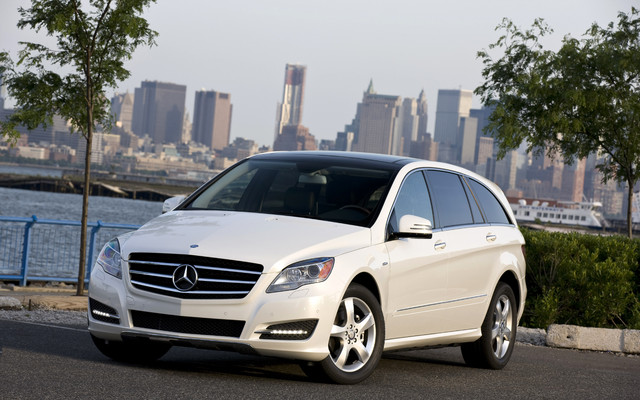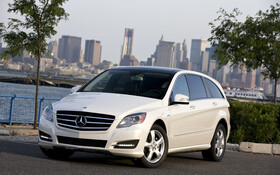2011 Mercedes R-Class: Welcome to the doldrums

| Strong points |
|
|---|---|
| Weak points |
|
It isn’t working. It just isn’t working, this mini-van/wagon that likes to think of itself as something else altogether, but it just can’t escape. And on top of that, it features the most numbing ride of any car in the line. The Mercedes R-Class doesn’t find many takers, at least in North America, and its most recent mid-cycle evolution won’t change that.
Maybe evolution isn’t the right word... Is it because there weren’t enough R-Classes sold that five years after its launch, the biggest change is the front grille? They took the visual signature of the rest of the Mercedes family and put it at the end of a hood that has the good fortune of being raised a little bit. The less plunging silhouette loses some of its dullness and gains some character. Also highlighting its overall qualities are the redesigned headlights and the optional line of LED lighting.
The rear lights have also been touched up and there are now integrated exhausts and new interior colours. Big deal… Among the other new features are the blind spot detection system that you can now order and the updated diesel engine that now consumes 0.3 litres less per 100 km.
No emotion, no connection
Besides that, there’s nothing new at all, which won’t help the R-Class sell more cars. Sure, this extra long vehicle is successful in China (the Chinese like their cars long), but it’s a totally different story on this side of the Pacific. A meagre 308 units were sold last year in Canada... Who’s to blame? Firstly, there’s the exterior design that makes it look like a bus. The R-Class wanted nothing else than to set itself apart from mini-vans and wagons, but it just hasn’t managed to create a new segment, as Mercedes had hoped. There’s always another SUV or crossover to steal its thunder. Not only are there its cousins the GL and ML that are also assembled at the American plant in Alabama, but there’s also the Volvo XC90, Audi Q7, Acura MDX and the most outstanding of the lot, the Lincoln MKT. Another reason for the R’s lack of success is its emotionless ride. Europe gets tighter steering, but America has to make do with such a watered-down ride that you don’t feel any connection at all to the road. What’s more, the handling is heavy and the vehicle is so wide that you have to think twice before venturing into an alley. And be careful parking: at 5.1 metres long, you won’t fit just anywhere, any way. Basically, the R-Class isn’t the least bit athletic.
Four of every five are diesels
Only two engines continue to be offered on our continent. There’s the 3.5-litre V6 gas engine (272 hp) and the 3.0-litre V6 BlueTec (211 hp). Nothing new there, and not surprisingly, it’s the diesel that is the favourite of Canadian buyers four out of five times. After driving both engine types, we understand why. With its 400 lbs-ft of torque and despite its 105 additional kilos, the V6 diesel delivers accelerations that are a half-second slower, but it does so in a much deeper and more engaging way. The 80-120km/hr accelerations are as dynamic as with the gas engine and, thanks to an impeccably soundproofed passenger compartment, the diesel is just as silent. As an added bonus, it’s much more fuel efficient (a savings of at least 3 litres per 100 km).
Do not abuse
The seven-speed automatic transmission is still on the menu and, as always, is so smooth that you have to keep an eye on the revs to know when it shifts from one gear to another. You never feel the need to intervene in the shifting process, but you could if you wanted, using the wheel-mounted controls. But let’s face it, when you’re driving an R-Class, it’s not exactly exhilarating so drivers won’t bother playing with these gizmos very often.
All-wheel drive still comes factory standard, which makes for reassuring handling, but don’t go pressing your luck too much in sharp turns because that’s where you’ll really feel the limits of its long wheelbase (3,215mm). And it definitely doesn’t take kindly to that kind of abuse.
On the other hand, the ride is very comfortable with that air suspension that seems to float above the pavement. There’s nothing to inject life into the driving experience... Having said that, it gets a 9.5/10 for its braking: being able to stop the more than 2,200 kilos from 100 to 0 km in 40 metres, that’s almost a miracle, especially when you consider that it takes another half-metre more (yes, more!) to stop the little B-Class...
Plenty of space…
The R-Class truly earns its stripes in the passenger compartment. It’s undeniably comfortable, the very supportive seats truly envelope you, the materials are excellent and they could not have been more meticulously assembled. You’re better off going with the six seat version because you’ll get the two captain’s chairs in the second row, which are a lot more comfortable than the bench (seven seat version) where the passenger in the middle will curse how small it is. The seats in the third row are limited, particularly when it comes to head room with that plunging roof line. Sure, the cargo space is gargantuan when all of the benches are lowered (up to 2,385 litres), but there’s barely 314 litres when all of the seats are occupied.It’s average.
One last spin around the block?
The folks at Mercedes will tell you that the R-Class is in a league of its own, and in our opinion, this lack of competition just goes to show what a dead end this type of “people hauler” is. If not, wouldn’t a lot more manufacturers have made this type of vehicle over the last five years? Instead, SUVs and crossovers are taking over. The R-Class didn’t manage to reinvent the wheel by changing the front grille. Don’t be surprised if this vehicle isn’t back for a 2nd generation and is quietly retired… We sure won’t miss it.











